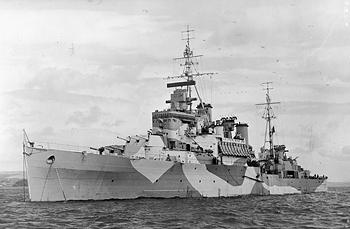![]() The Pacific War Online Encyclopedia
The Pacific War Online Encyclopedia
|
| Previous: Ugaki Matome | Table of Contents | Next: Ujjain |

Royal Navy. Via Wikipedia
Commons
| Tonnage | 8530 tons standard displacement |
| Dimensions | 555'6" by 62'0" by 19'10" 169.31m by 18.9m by 6.04m |
| Maximum
speed |
32.25 knots |
| Complement | 733 |
| Aircraft |
1 catapult 2 seaplanes |
| Armament | 3x3 6"/50 guns 4x2 4"/45 dual-purpose guns 12x2, 8x1 20mm Oerlikon AA guns 2x3 21" torpedo tubes |
| Protection | 3.5" (89mm) NC belt (magazines) 3.25" (83mm) NC belt (machinery) 2" (51mm) NC deck (magazines and engine rooms) 3.25" (83mm) NC deck (boiler rooms) 2" (51mm) turret |
| Machinery |
4-shaft Parsons geared turbine
(80,000 shp) 4 Admiralty 3-drum boilers |
| Bunkerage | 1700 tons fuel oil |
| Range | 6520 nautical miles (12,000 km) at 13 knots |
| Sensors |
Type 272 radar |
| Modifications |
Light antiaircraft
armament and radar steadily
improved. By the end of the war, Ceylon
had 6x2, 2x1 20mm Oerlikon guns and 4x1 40mm Bofors AA guns, Newfoundland had 10x2, 8x1 20mm
Oerlikon guns, and Uganda had
10x2, 8x1 20mm Oerlikon guns and 6x4, 4x1 2pdr AA guns. |
The Ugandas were originally laid down as Fijis
but their completion was delayed by the Dunkirk emergency. They were
eventually completed as "Modified Fijis"
with improved antiaircraft
defenses in place
of the fourth turret.
| Ceylon |
arrived 1944-11 |
|
| Newfoundland |
arrived 1944-11 | |
| Uganda |
arrived 1945-1 | Royal Canadian Navy |
References
The Pacific War Online Encyclopedia © 2008-2010 by Kent G. Budge. Index